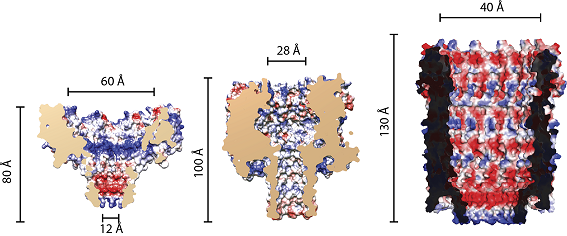Nanopore Design and Engineering
One of the main focus in our laboratory is to design and re-engineer membrane proteins and nanopores to modify their properties.
We use a range of techniques including directed evolution, genetic engineering, bioorthogonal chemical modifications (e.g. by covalently attaching DNA molecules) and computational approaches (with Prof. S. Marrink) to introduce target functions to the nanopore.
Nanopore design and engineering
Virtually all cells make proteins that form nanoscale holes on biological membranes, thus hundreds of biological nanopores are available. However, today only a few nanopores with different size, shape and properties are available. One important line of research in our laboratory is to characterise nanopores which structure is available (Figure below). Another is the de novo design nanopores with tailored properties.

Origin of Membrane Proteins
Arguably, one of the first events of cellular life was the formation of a permeable protective barrier that allowed the communication between the cell and the environment. We are aiming to recreate the spark that ignited cellular life by designing, engineering and evolving molecular components that specifically control cellular communication.
Publications
Soskine M, Biesemans A, Maglia G. Single-Molecule Analyte Recognition with ClyA Nanopores Equipped with Internal Protein Adaptors. J Am Chem Soc. 6;137(17):5793-7 (2015). DOI: 10.1021/jacs.5b01520.
Soskine, M, Biesemans, A, De Maeyer, M, and Maglia, G. Tuning the Size and Properties of ClyA Nanopores Assisted by Directed Evolution. J Am Chem Soc (2013). DOI: 10.1021/ja4053398
-Highlight in ChemistryViews
Further reading:
Engineeried transmembrane pores (2016)
Nanopore sensing (2016)
| Last modified: | 04 February 2020 10.58 a.m. |
